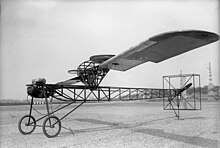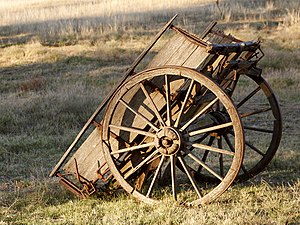 |
| Three wheels on an antique tricycle |
A wheel is a device that is capable of rotating on an axle through its center, facilitating movement or transportation while supporting a load (mass), or performing labor in machines. Common examples found in transport applications. A wheel, together with an axle, overcomes friction by facilitating motion by rolling. In order for wheels to rotate, a moment needs to be applied to the wheel about its axis, either by way of gravity, or by application of another external force. More generally the term is also used for other circular objects that rotate or turn, such as a ship's wheel, steering wheel and flywheel.
Etymology
The English word wheel comes from the Old English word hweol, hweogol, from Proto-Germanic *hwehwlan, *hwegwlan, from Proto-Indo-European *kwekwlo-, an extended form of the root *kwel- "to revolve, move around". Cognates within Indo-European include Greek κύκλος kýklos, "wheel", Sanskrit chakra, Old Church Slavonic kolo, all meaning "circle" or "wheel",

A depiction of an onager-drawn cart on the Sumerian "battle standard of Ur" (circa 2500 BCE)

A figurine featuring the New World's independently invented wheel
Evidence of wheeled vehicles appears from the mid 4th millennium BCE, near-simultaneously in Mesopotamia, the Northern Caucasus (Maykop culture) and Central Europe, and so the question of which culture originally invented the wheeled vehicle remains unresolved and under debate.
The earliest well-dated depiction of a wheeled vehicle (here a wagon—four wheels, two axles), is on the Bronocice pot, a ca. 3500–3350 BCE clay pot excavated in a Funnelbeaker culture settlement in southern Poland.
The wheeled vehicle from the area of its first occurrence (Mesopotamia, Caucasus, Balkans, Central Europe) spread across Eurasia, reaching the Indus Valley by the 3rd millennium BCE. During the 2nd millennium BCE, the spoke-wheeled chariot spread at an increased pace, reaching both China and Scandinavia by 1200 BCE. In China, the wheel was certainly present with the adoption of the chariot in ca. 1200 BCE,although Barbieri-Low argues for earlier Chinese wheeled vehicles, circa 2000 BCE.
Although they did not develop the wheel proper, the Olmec and certain other western hemisphere cultures seem to have approached it, as wheel-like worked stones have been found on objects identified as children's toys dating to about 1500 BCE. Early antiquity Nubians used wheels for spinning pottery and waterwheels. It is thought that Nubian waterwheels may have been ox-driven It is also known that Nubians used horse-driven chariots imported from Egypt.
The invention of the wheel thus falls in the late Neolithic, and may be seen in conjunction with the other technological advances that gave rise to the early Bronze Age. Note that this implies the passage of several wheel-less millennia even after the invention of agriculture and of pottery:
9500–6500 BCE: Aceramic Neolithic
6500–4500 BCE: Ceramic Neolithic (Halafian)
ca. 4500 BCE: invention of the potter's wheel, beginning of the Chalcolithic (Ubaid period)
4500–3300 BCE: Chalcolithic, earliest wheeled vehicles, domestication of the horse
3300–2200 BCE: Early Bronze Age
2200–1550 BCE: Middle Bronze Age, invention of the spoked wheel and the chariot
Wide usage of the wheel was probably delayed because smooth roads were needed for wheels to be effective. Carrying goods on the back would have been the preferred method of transportation over surfaces that contained many obstacles. The lack of developed roads prevented wide adoption of the wheel for transportation until well into the 20th century in less developed areas.
Early wheels were simple wooden disks with a hole for the axle. Because of the structure of wood a horizontal slice of a trunk is not suitable, as it does not have the structural strength to support weight without collapsing; rounded pieces of longitudinal boards are required. The oldest known example of a wooden wheel and its axle were found in 2003 at the Ljubljana Marshes some 20 km south of Ljubljana, the capital of Slovenia. According to the radiocarbon dating, it is between 5,100 and 5,350 years old.
The spoked wheel was invented more recently, and allowed the construction of lighter and swifter vehicles. The earliest known examples are in the context of the Andronovo culture, dating to ca 2000 BCE. Soon after this, horse cultures of the Caucasus region used horse-drawn spoked-wheel war chariots for the greater part of three centuries. They moved deep into the Greek peninsula where they joined with the existing Mediterranean peoples to give rise, eventually, to classical Greece after the breaking of Minoan dominance and consolidations led by pre-classical Sparta and Athens. Celtic chariots introduced an iron rim around the wheel in the 1st millennium BCE. The spoked wheel was in continued use without major modification until the 1870s, when wire wheels and pneumatic tires were invented.
The invention of the wheel has also been important for technology in general, important applications including the water wheel, the cogwheel (see also antikythera mechanism), the spinning wheel, and the astrolabe or torquetum. More modern descendants of the wheel include the propeller, the jet engine, the flywheel (gyroscope) and the turbine.
Timeline
Bronze Age disk wheel as depicted on the Standard of Ur (ca. 2500 BCE)
Classical Greek four-spoked chariot-wheel (as a Linear B glyph), in use from the 15th century BCE. Hittite and Egyptian chariots tended to have six spokes, Iron Age Assyrian ones eight.
Bronze Age "wheel pendants" of the Urnfield culture (ca. 1200 BCE), found in Zürich (Swiss National Museum)
An Early Iron Age spoked wheel from Choqa Zanbil (ca. 1000 BCE, National Museum of Iran)
Wheel of the Etruscan chariot (ca. 530 BCE)
The classic spoked wheel with hub and iron rim, in use from about 500 BC (Iron Age Europe) until the 20th century CE
Penny-farthing bicycle (1882)
Modern motorcycle alloy wheel with inflatable tire and disc brake
Michelin's "Tweel" airless tyre (2005)
Mechanics and function
The wheel is a device that enables efficient movement of an object across a surface where there is a force pressing the object to the surface. Common examples are a cart pulled by a horse, and the rollers on an aircraft flap mechanism.
Wheels are used in conjunction with axles, either the wheel turns on the axle, or the axle turns in the object body. The mechanics are the same in either case.
The low resistance to motion (compared to dragging) is explained as follows (refer to friction):
the normal force at the sliding interface is the same.
the sliding distance is reduced for a given distance of travel.
the coefficient of friction at the interface is usually lower.
Bearings are used to help reduce friction at the interface. In the simplest and oldest case the bearing is just a round hole through which the axle passes (a "plain bearing").
Example:
If dragging a 100 kg object for 10 m along a surface with the coefficient of friction μ = 0.5, the normal force is 981 N and the work done (required energy) is (work=force x distance) 981 × 0.5 × 10 = 4905 joules.
Now give the object 4 wheels. The normal force between the 4 wheels and axles is the same (in total) 981 N, assume, for wood, μ = 0.25, and say the wheel diameter is 1000 mm and axle diameter is 50 mm. So while the object still moves 10 m the sliding frictional surfaces only slide over each other a distance of 0.5 m. The work done is 981 × 0.25 × 0.5 = 123 joules; the friction is reduced to 1/40 of that of dragging.
Additional energy is lost from the wheel-to-road interface. This is termed rolling resistance which is predominantly a deformation loss.
A wheel can also offer advantages in traversing irregular surfaces if the wheel radius is sufficiently large compared to the irregularities.
The wheel alone is not a machine, but when attached to an axle in conjunction with bearing, it forms the wheel and axle, one of the simple machines. A driven wheel is an example of a wheel and axle. Note that wheels pre-date driven wheels by about 6000 years.
Stability
 |
| Static stability of a wheeled vehicle |
For unarticulated wheels, climbing obstacles will cause the body of the vehicle to rotate. If the rotation angle is too high, the vehicle will become statically unstable and tip over. At high speeds, a vehicle can become dynamically unstable, able to be tipped over by an obstacle smaller than its static stability limit. Without articulation, this can be an impossible position from which to recover.
For front-to-back stability, the maximum height of an obstacle which an unarticulated wheeled vehicle can climb is a function of the wheelbase and the horizontal and vertical position of the center of mass (CM).
The critical angle is the angle at which the center of mass of the vehicle begins to pass outside of the contact points of the wheels. Past the critical angle, the reaction forces at the wheels can no longer counteract the moment created by the vehicle's weight, and the vehicle will tip over. At the critical angle, the vehicle is marginally stable. The critical angle θcrit can be found by solving the equation:
where
r is the radius of the wheels;
xcm is the horizontal distance of the center of mass from the rear axle; and
ycm is the vertical distance of the center of mass from the axles.
For small wheels, this formula can be simplified to:
The maximum height h of an obstacle can be found by the equation:
where w is the wheelbase.

In the Unicode computer standard, theDharmacakra is called the "Wheel of Dharma" and found in the eight-spoked form. It is represented as U+2638 (☸)
While wheels are used for ground transport very widely, there are alternatives, some of which are suitable for terrain where wheels are ineffective. Alternative methods for ground transport without wheels (wheel-less transport) include:
Being raised by electromagnetic energy (maglev train and other vehicles)
Dragging with runners (sled) or without (travois)
Being raised by air pressure (hovercraft)
Riding an animal such as a horse
Human powered:
Walking on one's own legs
Being carried (litter/sedan chair or stretcher)
A walking machine
Caterpillar tracks (although it is still operated by wheels)
Spheres, as used by Dyson vacuum cleaners and hamster balls
In semiotics

The flag of Mahl Kshatriyas
The wheel has also become a strong cultural and spiritual metaphor for a cycle or regular repetition (see chakra, reincarnation, Yin and Yang among others). As such and because of the difficult terrain, wheeled vehicles were forbidden in old Tibet.
The winged wheel is a symbol of progress, seen in many contexts including the coat of arms of Panama and the logo of the Ohio State Highway Patrol.
The introduction of spoked (chariot) wheels in the Middle Bronze Age appear to have carried somewhat of a prestige. The solar wheel appears to have a significance in Bronze Age religion, replacing the earlier concept of a Solar barge with the more "modern" and technologically advanced solar chariot.
The wheel is also the prominent figure on the flag of India. The wheel in this case represents law (dharma). It also appears in the flag of the Romani people, hinting to their nomadic history and their Indian origins. The wheel can also appears in the flag of Mahl Kshatiyas Kings (kattiri buvana maha radun).
In recent times, the custom aftermarket car/automobile roadwheel has become a status symbol. These wheels are often incorrectly referred to as "rims". The term "rim" is incorrect because the rim is only the outer portion of a wheel (where the tire is mounted), just as with a coffee cup or meteor crater. These "rims" have a great deal of variation, and are often highly polished and very shiny. Some custom "rims" include a bearing-mounted, free-spinning disc which continues to rotate by inertia after the automobile is stopped. In slang, these are referred to as "Spinners".
Gallery
A driving wheel on a steam locomotive
0 Series Shinkansen wheel
A pair of wheels on a cart
An automobile wheel (1980's)
Training wheels are used to help the learner cope with instability of the two-wheel vehicle at low speeds.
(source:wikipedia)




































